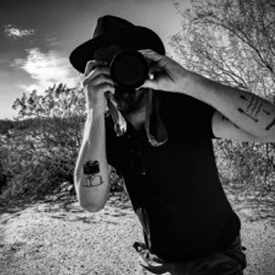 Jon Linton has always had a deep appreciation for the arts –– he just didn’t realize what a significant impact it would have on his life. After living in New York City and working in the fashion industry, Jon moved to Arizona to start a magazine dedicated to art. Years later, when his friend and officemate passed away under tragic circumstances, Jon needed something to help process what had happened. Picking up a camera he had casually used over the years, Jon began what would be a gradual shift from publisher to artist, all the while using photography as a way to pay honor to his friend’s memory.
Jon Linton has always had a deep appreciation for the arts –– he just didn’t realize what a significant impact it would have on his life. After living in New York City and working in the fashion industry, Jon moved to Arizona to start a magazine dedicated to art. Years later, when his friend and officemate passed away under tragic circumstances, Jon needed something to help process what had happened. Picking up a camera he had casually used over the years, Jon began what would be a gradual shift from publisher to artist, all the while using photography as a way to pay honor to his friend’s memory.
Today, Jon is recognized for his powerful black and white photographs, stretching from riveting street imagery to awe-inspiring landscapes. His inspirations include Ansel Adams and Edward Weston, who famously lifted photography into a respected category of fine art.
These days, with the abundance of smartphones and apps, anyone –– no matter their age or skill level –– can practice photography. Various software, online tools, etc., tend to help people with their passion for photography. Take for instance, if you know how to Convert tiff files on SodaPDf.com (or other similar applications), you would know how a .tiff file maintains the integrity and clarity of the picture. However, as with any medium, there are some guardrails to consider. One thing Jon has noticed is people’s propensity to push a photo’s vibrancy levels too far, which can cause an image to look distorted and like nothing a person would see with the naked eye.
“When you strip color away, you’re left with the truth of the image,” Jon says. “In the absence of color, you start looking at the subject matter you’re in front of very differently, and your eye automatically starts picking up texture.”
Choosing to flex his creativity by focusing on black and white, Jon’s photos convey a level of depth and substantiality that makes them hard to turn away from.
“There’s a picture I have of a desert road, and you almost feel like you could walk into the piece because of the texture that you see,” he says. “The shadows and the way light plays are so important in black and white photography.”
As much as one may master the technical aspects of photography, Jon believes a photographer will only find success once they capture the mystery in a subject.
“You want the work to leave someone in a certain feeling or mood,” he says. “If we walk by something and it doesn’t grab us, it’s because there’s an absence of mystery. That’s kind of like life –– without some mystery in life, we’d live a very bland existence. I try to make certain that my work reflects that.”
For an artist who is known for seizing moments and evoking an array of emotions in people, Jon relishes being able to connect with art lovers in person at the Celebration of Fine Art and discuss the stories and subtle details behind the art.
“Galleries can’t share the intimate details of the work the way the artist who created it can,” he says. “The Celebration of Fine Art affords collectors the opportunity to make a connection to the work and to the artist. That’s really what sets this apart from so many other shows.”
See more of Jon’s story below:

